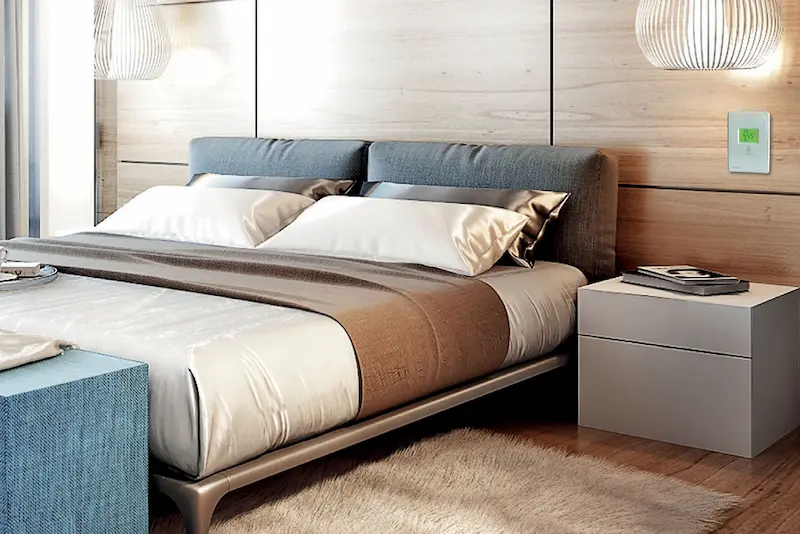All About Carbon Dioxide Monitors

Modern homes are better insulated than ever before!
It's great news for energy efficiency, not so great for ventilation.
In this post, we investigate why seemingly harmless carbon dioxide can be a danger in homes and offices, and what you need to do about it.
House building techniques have come a long way since the delightful, but draughty, era of Victorian red-bricks. The houses we build today are better insulated, warmer, more energy efficient and virtually air tight. This is great, but air quality must be maintained.
Those living or working in new-build properties risk breathing in too much of the carbon dioxide they and those around them emit [GCSE chemistry here folks, we breathe in oxygen, breath out carbon dioxide]. The risk is such that it's prompted the Scottish Government to require the installation of carbon dioxide monitors in all domestic homes.
CARBON DIOXIDE VS. CARBON MONOXIDE
Before we go any further, carbon dioxide [CO2] monitors are not to be confused with carbon monoxide [CO] monitors.
Carbon dioxide is naturally occurring: we're exposed to it in the air we breathe, the cleaning products we use, we even add it to our foods and drinks when we use baking soda and baking powder. Carbon monoxide, meanwhile, is the toxic product of combustion, which is why any home with solid fossil fuel burning appliances such as a wood burning heater or an open fireplace must have a carbon monoxide monitor.
So while both monitors detect the presence of an odourless and colourless gas and while both gases have carbon and oxygen in them; they are not the same and should not be confused.
Right, chemistry lesson over.
Symptoms of inhaling too much carbon dioxide include drowsiness, headaches and poor concentration. "If you experience any of these symptoms, that's a good indication of poor air quality in your room and therefore poor ventilation in your home," says Andrew Pegrum, Technical Manager at Deta Electrical, which brought to market the first carbon dioxide monitor designed for domestic use.
Other tell-tale signs to look for include shortness of breath [or having to take deeper breaths], getting tired easily, dizziness, confusion or even losing consciousness. So next time you have a headache or feel drowsy for no apparent reason, take a look at your surroundings, and if you're in an enclosed space, open a window.
MODERN HOUSE BUILDING
Unlike carbon monoxide monitors, carbon dioxide monitoring is more about air quality than poisoning, as Andrew explains: "A carbon dioxide monitor will measure the air quality in a room, whereas a carbon monoxide detector will measure the particles given off by fossil burning fuels."
Having worked in the electrical trade for nearly 30 years, Andrew says it's a combination of modern building techniques and regulations that's led to the need for carbon dioxide monitors.
"With new and current house building techniques, you end up having a house that's quite airtight to meet certain building regulations," explains Andrew. "And those airtight conditions, if you don't introduce good ventilation and airflow through it, can lead to poor air quality and a build-up of carbon dioxide."
THE WINDOW QUESTION
So...why doesn't everyone just open a window? The simple answer, according to the Scottish Government's Technical Handbook 2015, is that most residents have no idea what the air quality in their home is, or should be, and therefore don't know that they need to open a window, hence the need for monitors.
Then there's the security factor. Some residents – particularly those who are elderly or non-able bodied – feel less secure sleeping with an open window, for fear of a person breaking and entering. Parents, meanwhile, might prefer to keep windows locked to prevent adventurous children climbing onto windowsills and falling out – every parent's nightmare. Finally, there's the issue of weather. Rain, wind and freezing temperatures frequently stop residents from opening windows. The answer? Fit a carbon dioxide monitor.
INSTALLING A MONITOR
The ideal place for a monitor is in the principal bedroom away from the window, as Andrew, explains: "Our monitor is designed to sit on the wall. It's a surface mounting product and the unit is aesthetically pleasing."
And as for knowing which levels are correct, the monitor has an easy to use traffic light system – green meaning all is fine, amber meaning that ventilation needs addressing and red meaning the ventilation is poor.
"The traffic light system really helps" says Andrew.


